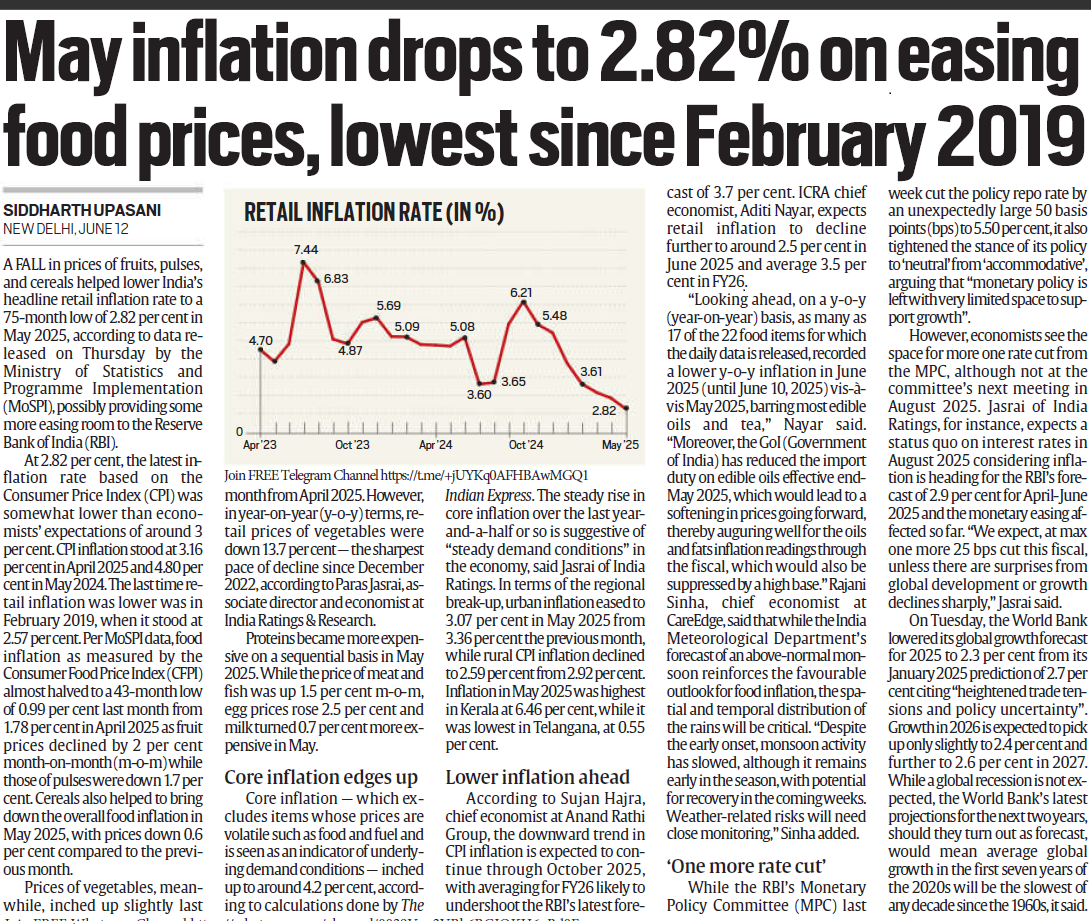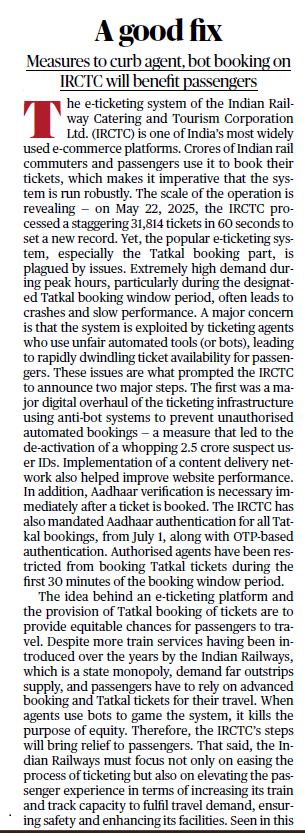
Source: The hindu
Relevant to: International Relations, Economy, Polity
The article analyses the impact of former U.S. President Donald Trump’s sweeping tariffs on international trade, focusing on U.S.-India trade ties, legal challenges by U.S. companies, and India’s strategic options in trade negotiations.
What are Trump’s Tariffs?
- Imposed tariffs between 10% to 135% on imports from over 100 countries.
- Claimed to address U.S. trade deficits via “national emergency” under Section 232 of the U.S. Trade Expansion Act.
Legal and Constitutional Challenge:
- U.S. businesses sued the U.S. administration for bypassing Congressional authority.
- The U.S. Court of International Trade (CIT) ruled the executive acted unlawfully in applying tariffs without proper authorization.
Global Trade Implications:
- The Global Trade Research Initiative estimates U.S.-India bilateral trade at $35–$40 billion annually.
- India’s exports like steel, aluminium, digital services affected.
- U.S. also impacted India’s Generalized System of Preferences (GSP) benefits.
India’s Position and Challenges:
- India retaliated with tariffs on U.S. goods.
- Faced WTO scrutiny when imposing counter-tariffs.
- India should avoid any “sub-optimal trade deal” under pressure from transactional U.S. policies.
Strategic Suggestions for India:
- Ensure Balanced Digital Trade Policies (like cross-border data flow rules).
- Push for restoring GSP benefits.
- Secure removal of additional U.S. tariffs.
- Caution against Trump-style unilateralism; India should anchor its position within WTO norms and multilateral frameworks.
Way Forward:
- U.S.-India must balance commercial interests with legal procedures.
- Ensure India’s long-term trade interests are not compromised under transactional threats.
- Promote a fair and rules-based trade regime globally.
MCQ:
Consider the following pairs:
Initiative/Provision | Description |
|---|---|
1. Global Trade Research Initiative | Estimated U.S.-India bilateral trade |
2. Trump’s Beautiful Bill (OBBB) | Aimed to limit judicial review in U.S. |
3. GSP (Generalized System of Preferences) | U.S. preferential trade scheme for India |
Which of the above pairs is/are correctly matched?
A) 1 and 2 only
B) 2 and 3 only
C) 1 and 3 only
D) 1, 2 and 3
Answer: D
Explanation:
All three are correctly matched based on the context of the article.

Source: The hindu
Relevant to: Governance
- As part of the Viksit Bharat 2047 vision, urbanisation is expected to drive economic transformation.
- India needs to develop efficient, sustainable, and financially viable public transport systems to manage increasing urban mobility needs.
Urban Mobility Challenge:
- By 2060s, over 60% of India’s population is projected to live in urban areas.
- There is a lack of new smart cities, unlike countries like China.
- Existing metros and Tier 1 cities face overburdened transport infrastructure.
Government Initiatives:
- PM e-Bus Sewa: Introduced in the Union Budget to deploy 10,000 new e-buses.
- PM Electric Drive Revolution (PM e-Drive): Supporting electric vehicles like e-rickshaws, e-trucks, e-ambulances.
- India needs 2,00,000 urban buses, but only 25,000 are currently operational.
Concerns Raised:
- Lack of cost-efficiency and sustainability analysis in planning transport systems.
- Trams and trolleybuses are overlooked despite being:
- More profitable over time.
- Environmentally aligned.
- More stable in lifecycle cost.
MCQ:
Consider the following statements regarding urban public transport in India:
- Trams show a long-term profitability of 45% over seven decades.
- E-buses result in a net profit of 82% due to their electric nature.
- India needs nearly 2,00,000 urban buses, but currently, only about 25,000 are operational.
Which of the above statements is/are correct?
A) 1 and 2 only
B) 2 and 3 only
C) 1 and 3 only
D) 1, 2 and 3
Answer: C
Explanation:
- Statement 1 is correct (as per long-term lifecycle analysis).
- Statement 2 is incorrect; e-buses show a net loss, not profit.
- Statement 3 is correct as per estimates in the article.

Source: Indian Express
Relevant to: Governance (Urban Services, Emergency Response) ,Science & Technology (Application of tech in public service delivery)
- Urban traffic congestion in Indian metros like Bengaluru, Delhi, and Mumbai significantly affects ambulance response times, which can lead to preventable deaths.
- The article highlights the importance of leveraging technology to reclaim the “Golden Hour” — the critical period to save lives in medical emergencies.
What is the Golden Hour?
- The first 60 minutes after trauma or a medical emergency, which is crucial for survival.
- Delays in reaching medical aid during this period significantly reduce the chances of recovery.
Current Challenges:
- Traffic delays worsen patient outcomes; e.g., Delhi’s average ambulance response time rose from 13 to 17 minutes.
- Audit Reports (CAG) on Karnataka showed:
- ~90,000 crash victims didn’t get timely care.
- Dispatch delays in 6,000 cases by over 30 minutes.
- National Average: 25–30 minutes; worse in rural areas.
Barriers to Efficiency:
- Infrastructure Gaps:
- Less than 20% of traffic lights in Indian cities support signal override systems.
- Many cities still depend on manual or timer-based signals.
- Technology Limitations:
- GPS systems suffer from glitches.
- Emergency apps/devices often lack integration.
- Public Apathy:
- 62% of ambulance drivers say motorists do not yield.
- 45% say they must request clearance from vehicle to vehicle.
Innovative Interventions:
- GPS-based ambulance tracking:
- Real-time location, alerts, and route optimization.
- In Chennai and Kolkata, reduced response time by 12–15%.
- Signal Override Systems:
- Allow ambulances to auto-trigger green signals.
- Pilot projects underway in few cities.
- Karnataka’s “Platinum Ten Minutes” initiative:
- Target: First responders at trauma sites within 6 minutes.
- Effective in reducing fatality risk significantly.
- GPS-based ambulance tracking:
Way Forward:
- Upgrade traffic infrastructure to support automated signal overrides.
- Improve public awareness and stricter enforcement of “ambulance right of way” laws.
- Wider rollout of emergency tech integration (GPS, alerts, dashboards).
- Mandate door-to-CT scan time for stroke/cardiac patients.
- Cross-sector coordination (health, transport, civic bodies) is essential.
MCQ:
Consider the following statements:
- The “Golden Hour” refers to the first hour after a trauma when timely medical intervention is most effective.
- Karnataka’s “Platinum Ten Minutes” initiative aims to ensure ambulance arrival at trauma sites within 10 minutes.
- Only about 50% of India’s traffic signals currently support signal override systems for ambulances.
Which of the above statements is/are correct?
A) 1 and 2 only
B) 2 and 3 only
C) 1 and 3 only
D) 1, 2 and 3
Answer: A
Explanation:
- Statement 1 is correct: The Golden Hour is a critical life-saving window.
- Statement 2 is correct: Karnataka targets 6 minutes arrival, which falls within the “Platinum Ten”.
- Statement 3 is incorrect: Less than 20% of traffic signals support override systems.

Source: Indian express
Relevant to: Indian Economy – Inflation, Monetary Policy
India’s retail inflation fell to 2.82% in May 2025, its lowest level since February 2019, due to a drop in food prices—especially fruits, pulses, cereals, and vegetables.
Current Inflation Trends (May 2025):
- CPI inflation: 2.82%
- Down from 3.16% in April 2025 and 4.80% in May 2024
- Core inflation (excluding food & fuel): Edged up slightly, but within manageable range
- CPI inflation: 2.82%
Food Price Impact:
- Food inflation eased to 3.3% in May from 4.2% in April
- Pulses fell 2% month-on-month
- Cereals: Down 1.7%
- Fruits & vegetables: Declined
- Onion prices fell 22.5%; tomato prices by 16.3%
Government & RBI Responses:
- MoSPI (Ministry of Statistics and Programme Implementation) released the inflation data.
- RBI may find more room for rate cuts in upcoming Monetary Policy Committee (MPC) meetings.
- Repo rate currently at 5.50% (after 50 bps hike earlier)
- Analysts expect repo rate to fall to 5.25% in late 2025, and potentially further to 2.5% in FY26
Expert Views:
- Aditi Nayar (ICRA): Inflation may fall to 2.5% by June 2025
- Sujan Hajra (Anand Rathi): Disinflation to continue till Oct 2025
- Rajani Sinha (CareEdge): Favorable weather and vegetable prices supported decline
Regional Price Trends:
- Lowest inflation in Telangana: 0.55%
- Highest in Odisha: 6.46%
MCQ:
In May 2025, India’s retail inflation fell to its lowest level since which of the following years?
A) 2021
B) 2020
C) 2019
D) 2018
Answer: C
Explanation: Retail inflation fell to 2.82% in May 2025, the lowest since February 2019.

Source: The hindu
Relevant for: Governance
The IRCTC (Indian Railway Catering and Tourism Corporation Ltd.) is upgrading its ticketing system to counter the misuse of automated bots and agent-based unfair bookings, especially during the Tatkal booking window.
- Record Load on System:
- On May 22, 2025, IRCTC processed 31,814 tickets in 60 seconds – setting a new record.
- System Exploitation:
- High demand during peak hours and Tatkal window causes system crashes and delays.
- Agents and bots misuse automated tools, reducing availability for genuine passengers.
- Passenger Inconvenience:
- Leads to frustration due to inability to access limited Tatkal tickets.
- Widespread public criticism and need for transparency.
Steps Taken by IRCTC:
- Major Digital Overhaul:
- Anti-bot mechanisms implemented to block automated unfair bookings.
- Resulted in deactivation of 2.5 crore suspicious user IDs.
- Content Delivery Network (CDN):
- Improves website speed and reduces crashes.
- Aadhaar Authentication:
- Mandatory for all Tatkal bookings from July 1, 2025, with OTP-based verification.
- Ensures only genuine users can book Tatkal tickets.
- Agent Booking Restrictions:
- Authorized agents banned from booking Tatkal tickets during the first 30 minutes of the Tatkal window.
MCQ:
Which of the following measures has IRCTC introduced to prevent bot and agent misuse in Tatkal bookings?
- Aadhaar authentication
- OTP-based login verification
- Agent ban for first 30 minutes
- Integration with DigiLocker
Select the correct option:
A) 1, 2 and 3 only
B) 1, 2 and 4 only
C) 2 and 4 only
D) 1, 2, 3 and 4
Answer: A
Explanation: Aadhaar + OTP authentication and agent restrictions were implemented. No mention of DigiLocker.

Source: The hindu
Relevant to: IR, Bilateral Relations
Prime Minister Narendra Modi will attend the G-7 Summit in Canada (June 15–17, 2025) as a special invitee, marking his first visit to Canada in 10 years. The visit is being viewed as a potential diplomatic reset in strained India-Canada relations.
Background of India-Canada Tensions:
- Tensions worsened after Canada’s allegations (under former PM Justin Trudeau) linking India to the killing of Khalistani separatist Hardeep Singh Nijjar.
- In retaliation:
- Diplomatic staff was cut by two-thirds.
- FTA talks were suspended by Canada.
- India suspended visa services for Canadian citizens.
Key Issues to Address:
- Diplomatic Normalisation:
- Restoration of High Commissioners.
- Resumption of India-Canada FTA discussions.
- Security Concerns:
- India’s demand to curb Khalistani threats to its diplomats and cultural centers.
- Bilateral Signaling:
- Both leaders, PM Modi and newly appointed PM Mark Carney, need to show mutual respect and issue positive public statements.
Significance of the G-7 Summit:
- Not a bilateral summit, but offers a neutral platform for dialogue.
- Can facilitate informal conversations and confidence-building measures.
- However, a lasting diplomatic thaw will require sustained engagement behind the scenes.
Diaspora Factor:
- Over 1.86 million Indians live in Canada, forming a strong people-to-people bridge.
- Cultural, educational, and economic ties remain strong despite political friction.
MCQ:
What is the primary objective of PM Modi’s participation in the G-7 Summit in Canada in June 2025?
A) To sign a trade pact with Canada
B) To attend the summit as a G-7 member
C) To explore a diplomatic reset with Canada amid strained relations
D) To sign a bilateral agreement on defense cooperation
Answer: C
Explanation: PM Modi is attending the G-7 summit as a special invitee, with hopes of improving strained ties with Canada.
